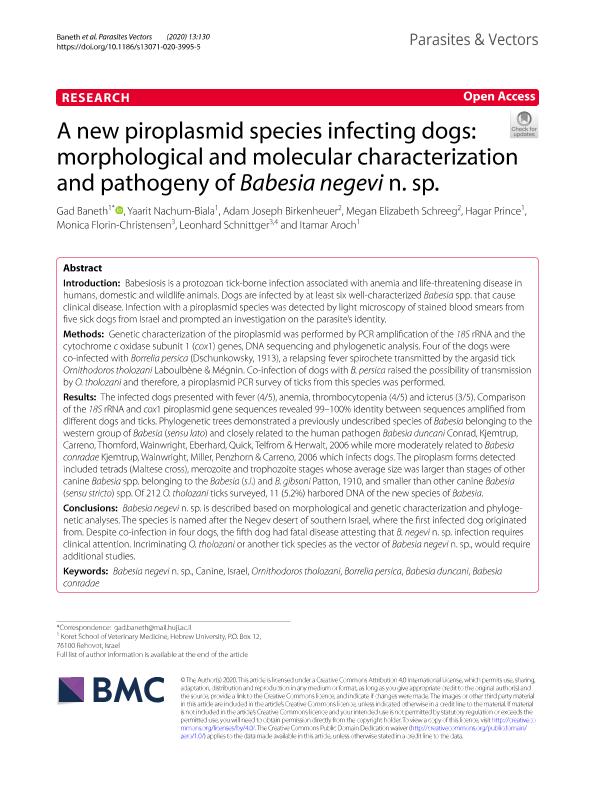Artículo
A new piroplasmid species infecting dogs: Morphological and molecular characterization and pathogeny of Babesia negevi n. sp.
Baneth, Gad; Nachum Biala, Yaarit; Birkenheuer, Adam Joseph; Schreeg, Megan Elizabeth; Prince, Hagar; Jacobsen, Monica Ofelia ; Schnittger, Leonhard
; Schnittger, Leonhard ; Aroch, Itamar
; Aroch, Itamar
 ; Schnittger, Leonhard
; Schnittger, Leonhard ; Aroch, Itamar
; Aroch, Itamar
Fecha de publicación:
04/2020
Editorial:
BioMed Central
Revista:
Parasites and Vectors
ISSN:
1756-3305
Idioma:
Inglés
Tipo de recurso:
Artículo publicado
Clasificación temática:
Resumen
Introduction: Babesiosis is a protozoan tick-borne infection associated with anemia and life-threatening disease in humans, domestic and wildlife animals. Dogs are infected by at least six well-characterized Babesia spp. that cause clinical disease. Infection with a piroplasmid species was detected by light microscopy of stained blood smears from five sick dogs from Israel and prompted an investigation on the parasite's identity. Methods: Genetic characterization of the piroplasmid was performed by PCR amplification of the 18S rRNA and the cytochrome c oxidase subunit 1 (cox1) genes, DNA sequencing and phylogenetic analysis. Four of the dogs were co-infected with Borrelia persica (Dschunkowsky, 1913), a relapsing fever spirochete transmitted by the argasid tick Ornithodoros tholozani Laboulbène & Mégnin. Co-infection of dogs with B. persica raised the possibility of transmission by O. tholozani and therefore, a piroplasmid PCR survey of ticks from this species was performed. Results: The infected dogs presented with fever (4/5), anemia, thrombocytopenia (4/5) and icterus (3/5). Comparison of the 18S rRNA and cox1 piroplasmid gene sequences revealed 99-100% identity between sequences amplified from different dogs and ticks. Phylogenetic trees demonstrated a previously undescribed species of Babesia belonging to the western group of Babesia (sensu lato) and closely related to the human pathogen Babesia duncani Conrad, Kjemtrup, Carreno, Thomford, Wainwright, Eberhard, Quick, Telfrom & Herwalt, 2006 while more moderately related to Babesia conradae Kjemtrup, Wainwright, Miller, Penzhorn & Carreno, 2006 which infects dogs. The piroplasm forms detected included tetrads (Maltese cross), merozoite and trophozoite stages whose average size was larger than stages of other canine Babesia spp. belonging to the Babesia (s.l.) and B. gibsoni Patton, 1910, and smaller than other canine Babesia (sensu stricto) spp. Of 212 O. tholozani ticks surveyed, 11 (5.2%) harbored DNA of the new species of Babesia. Conclusions: Babesia negevi n. sp. is described based on morphological and genetic characterization and phylogenetic analyses. The species is named after the Negev desert of southern Israel, where the first infected dog originated from. Despite co-infection in four dogs, the fifth dog had fatal disease attesting that B. negevi n. sp. infection requires clinical attention. Incriminating O. tholozani or another tick species as the vector of Babesia negevi n. sp., would require additional studies.
Archivos asociados
Licencia
Identificadores
Colecciones
Articulos (IPVET)
Articulos de INSTITUTO DE PATOBIOLOGIA VETERINARIA
Articulos de INSTITUTO DE PATOBIOLOGIA VETERINARIA
Citación
Baneth, Gad; Nachum Biala, Yaarit; Birkenheuer, Adam Joseph; Schreeg, Megan Elizabeth; Prince, Hagar; et al.; A new piroplasmid species infecting dogs: Morphological and molecular characterization and pathogeny of Babesia negevi n. sp.; BioMed Central; Parasites and Vectors; 13; 1; 4-2020; 1-13
Compartir
Altmétricas



